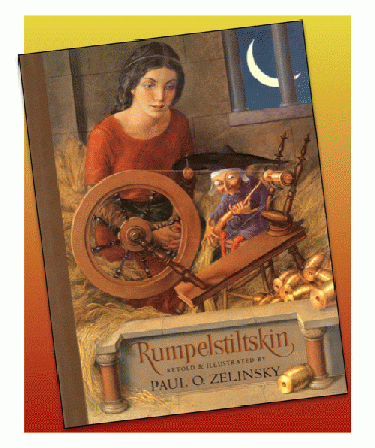
Cover art for 'Rumpelstiltskin', written and illustrated by Paul O. Zelinsky
(Image by courtesy of Paul O. Zelinsky) Details DMCA
But in both cases, the books were only what the pop-up community (I've since learned) calls "flat books." It wasn't until I finished my Rumpelstiltskin in 1986 that I felt I was ready to try my hand at this mechanical book. Dutton decided to create it through the company that at the time was producing most of the pop-up books in the country, as a packager subcontracting for other publishers. Intervisual Books (which had quite a story of its own), with paper engineers on staff in its Los Angeles office, would lead me through the process of turning my ideas into a physical book. It wouldn't exactly be a pop-up book, because almost nothing in it pops up, but "pop-up" is the term people use so much for movable books like this that by now even I go along and call The Wheels on the Bus a pop-up.
JB: That is a fun story. How many iterations did it take to get it exactly how you wanted it? What did you find particularly challenging to pull off? What worked and what didn't? And how did you make it sturdy enough that it didn't fall apart after engagement by one enthusiastic toddler?
THE MECHANICS BEHIND THE SCENES
PZ: I drew up my first draft as a page of thumbnail drawings, without much thinking about what would move and how. I assumed that I had 32 pages to work with, like a normal picture book. Then I learned that pop-up books are very expensive to produce, and that a lavish maximum length would be eight spreads. (A 32-page flat book has 15 double-page spreads, or 17, if you count the endpapers, which in pop-ups are full-fledged spreads).
So I went back to the drawing board and started boiling down, pushing some elements together into single spreads and leaving out a lot of others. I think I went through three versions, very roughly sketched in small sizes, to get to an eight-spread sketch that I liked.
As to the moving parts, I wanted to get an idea of possibilities, so I went to a good bookstore and bought all the books with mechanical parts that appealed to me (not popping up but moving sideways), took them back to my studio, and, feeling incredibly guilty for doing this, tore the pages out and cut them open to see how they worked. One of these books, by far the best, was a tribute to, and recreation of, the movable books of a renowned 19th century master of the art named Lothar Meggendorfer. That book has gone on to be a valuable rare book of its own, and I'm doubly conflicted about having torn it to pieces, but it was a necessary act!
JB: It took me years just to fold page corners or write notes, even in cookbooks. So I get it.
PZ: My book-slaughtering foray gave me lots of ideas for the movements in my Wheels book, but I wasn't responsible for devising the mechanics. Intervisual had paper engineers for that, though I wasn't in direct touch with them. Their sales rep, who was my contact, requested a full-sized dummy, where I would sketch the pictures and write indications of the movements I was asking for.
In a surprisingly short time after delivering that dummy, we got back a full-sized book from Intervisual's California office. It was a hardcover model of The Wheels on the Bus, eight spreads of stiff white paper, completely blank but with moving parts in place. Only if you knew my drawings could you make any sense out of it; here and there on the white pages would be some inscrutable cut-out shape that could move. Unfortunately, it wasn't remotely what I wanted; instead of ingenious hidden machinery inside the pages, these were all do-it yourself movements: to open the window, you lifted a flap. For the bus driver to move his arm back and forth in a "move on back" gesture, you would push the hand back and forth on its pivot. And so on.
JB: How disappointing! How did you handle that?
PZ: To let Intervisual know what I had in mind, I went into control-freak mode and did it all myself. Actually, I had tentatively made some moving pieces before this, but hadn't sent them in because maybe there were better ways to do them. But now I tried to channel the two most ingenious paper engineers I'd come across, Lothar Meggendorfer and Julian Wehr, and fully indulging my tendency to complicate things, produced an elaborate dummy which got sent to Intervisual. We waited to see what they would do next.
Before and After: mock up of bus doors and below, color dummy
(Image by courtesy of Paul O. Zelinsky) Details DMCAThey did a smart thing. They removed the first paper engineer and assigned another one who understood my intentions. If the first blank dummy hadn't been so awful, I don't know if I would have been as ecstatic over the second one, but it was pretty great right from the start. I asked for a few changes, but basically the mechanics of the book were set. And happily for me, most of them were based on my models, though paper engineer Rodger Smith had adapted them to be manufacturable, and as sturdy as possible, which was certainly important for a book like this. It is far from baby-proof, but it's much sturdier than it might have been, which I credit to a combination of Rodger's knowledge, and luck in my choices of movements.
Next Page 1 | 2 | 3 | 4 | 5 | 6
(Note: You can view every article as one long page if you sign up as an Advocate Member, or higher).







